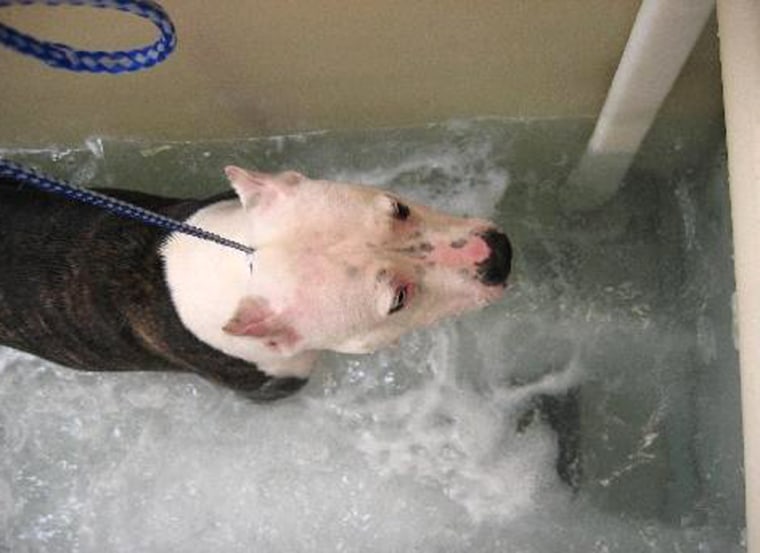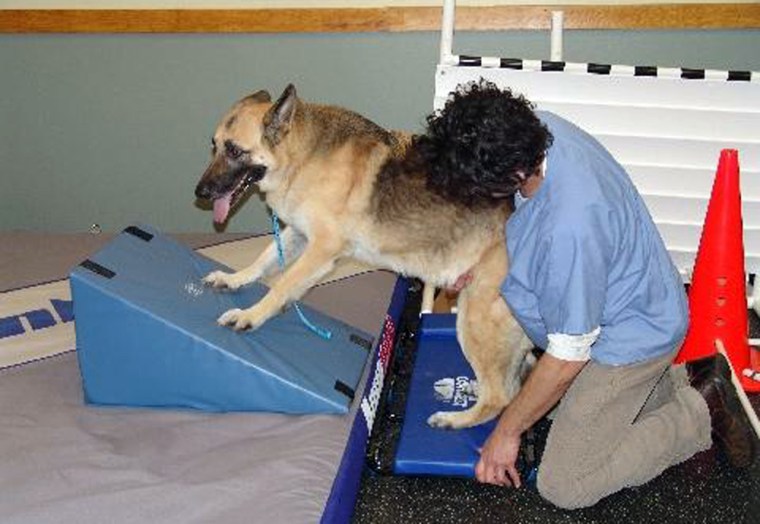Mikey was hit by a car, fracturing his upper front leg. Mocha had severe degenerative joint disease that affected his elbows, hips, knees and back. Doc had a painful ruptured disk, causing him to be unable to use his hind legs or control his bladder and bowels.
But through the use of underwater treadmills, electrical stimulation, range-of-motion exercises, massage and other equipment and techniques derived from physical therapy in people, Mikey and Mocha are active dogs with full use of their limbs. Doc is able to walk, no longer suffers from incontinence and continues to improve.
If Mikey, Mocha and Doc had been human, physical therapy would be an expected part of their treatment. But as dogs they were fortunate to benefit from veterinary rehab, a relatively new but quickly growing field.
"It’s advanced very rapidly in the last 10 years, in line with people’s expectations of their own physical therapy," says veterinarian Michael Andrews, president of the American Animal Hospital Association. "We’ve seen more and more people participating in physical therapy for their own injuries, and that’s spilled over into veterinary medicine as well."

Experts say physical rehabilitation can be a helpful tool for animals that are recovering from surgery for orthopedic or neurological problems, have incurred injuries to joints or soft tissue, or suffer from chronic pain.
Rehab can help pets recover more quickly, increase mobility and flexibility, improve endurance and agility, and reduce the need for pain medication. Before surgery, rehab can help pets lose weight, reduce pain and gain muscle, all of which can eliminate the need for surgery or improve its success. And after surgery, weeks of cage rest have been replaced by rehab techniques that begin almost immediately, including cold therapy to reduce inflammation. It’s also popular for conditioning athletic or working dogs.
At VetHab, a clinic in Raleigh, N.C., veterinarian John Sherman — who treated Mikey, Mocha and Doc — sees pets with ruptured anterior cruciate ligaments or developmental diseases such as hip and elbow dysplasia, top field trial dogs whose owners want a conditioning program to help prevent injury, and older pets whose joints have stiffened with age.
In addition to more people wanting their beloved pets to have the same type of care they receive, Sherman attributes the growing popularity of rehab to other factors, including more dog sports. “A lot more people do things with pets these days,” he says. “If you look at the list of sports or activities you can do with your dog, it’s a lot longer than you would think. People want their dog to be as good as it can and be safe.”
And because pets are living longer, more of them are facing health issues that affect mobility, such as osteoarthritis. Helping older pets maintain quality of life and mobility is becoming a new area of medicine, Sherman says.
Rehab is mostly used in dogs, who are more prone to injury than cats. But practitioners also see felines, especially those that have had a limb amputated, suffer neurologic problems, have arthritis or are just plain fat.
Pudgy dogs go in for rehab, too. Abby’s stomach dragged on the ground when she walked. The corgi weighed 48 pounds, more than double the low end of the breed’s recommended weight of 21 to 30 pounds. Abby’s owner had physical disabilities of her own and couldn’t give the dog the exercise she needed.
“This poor little puppy’s stomach had sores on it from dragging on the ground,” says veterinarian Pam Nichols of K-9 Rehab Center in West Bountiful, Utah. “She couldn’t even walk from our exam room to our scale without stopping and sitting and huffing and puffing.”
After six weeks of workouts on the underwater treadmill, Abby could do three sessions of 45 minutes each on the device and had lost 15 pounds. “She still comes in a couple of times a week, and it’s so exciting to see so huge a change for this little dog,” Nichols says. “The mom’s goal was just for her to be able to climb stairs, and now she runs and jumps and plays.”
Beyond treadmills and aquatic therapy (which benefit cats as well as dogs), pet rehab techniques encompass exercises involving exercise balls and balance boards, neuromuscular electrical stimulation, therapeutic ultrasound and the application of heat and ice.
“All of these treatments are aimed toward helping the dog regain range of motion, tissue mobility, strength and function, whether that is competing in agility, working as police or therapy dogs, or just being able to get up on the couch again,” says Amy Kramer of Manhattan Beach, Calif., who is a certified canine rehabilitation therapist.
'Homework' for the owners
And rehab involves more than just workouts at the rehab clinic. While most people don't have an underwater treadmill or swim tank at home, rehab specialists say that “homework” done by owners is crucial for long-term success. Owners can apply ice as needed, learn massage and exercise techniques, and even employ such high-tech devices as pulsed electromagnetic (PEM) therapy units.
The PEM treatment, for instance, which stimulates cartilage growth, requires nine treatments. “It can be done once a day for nine days, or we’re actually finding that it works better if we can do it twice a day for four and a half days,” says veterinarian Laurie McCauley of TOPS Veterinary Rehabilitation in Grayslake, Ill.
Rather than requiring owners to bring pets in daily for nine days or board them for four and a half days — to facilitate the eight hours required between treatments — McCauley has acquired two portable units. “We teach people how to do it, and then they can do it at home,” she says.
Rehab results often are rapid, with many pets showing improvement after just one treatment. Expect to see some result within a few visits, says Amie Lamoreaux Hesbach of Port Republic, Md., a certified canine rehabilitation practitioner.
The time required for complete recovery usually ranges from two to four months. “Chronic conditions ... might benefit from rehabilitation on a regular or irregular basis for an extended period,” Lamoreaux Hesbach says.
As for costs, an initial consultation that includes a physical exam, neurological exam and gait analysis usually runs $150 to $200. After that, costs depend on the type of therapy needed and whether the pet has any special needs. Rehab for a kitty amputee or an Italian greyhound with a bum knee will cost less than rehab for a 200-pound quadriplegic Great Dane. Pet insurance often covers at least some of the costs.
"Most people will spend between $500 and $1,500 over a couple of months," Nichols says. "The animals are coming in and spending a whole day and going through the treadmill and doing the swim thing and doing Theraballs. It’s about $75 a day, which is less than hospitalization."
Clients on a budget can stretch out rehab, taking pets in twice a week instead of three or four times a week, or can learn to do some of the exercises and treatments at home.
Kim Campbell Thornton is an award-winning author who has written many articles and more than a dozen books about dogs and cats. She belongs to the Dog Writers Association of America and is past president of the Cat Writers Association. She shares her home in California with three Cavalier King Charles Spaniels and one African ringneck parakeet.
Creature Comforts appears the third Monday of every month.
